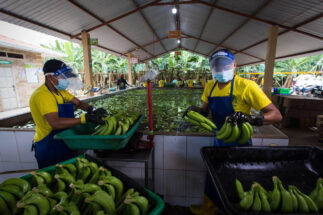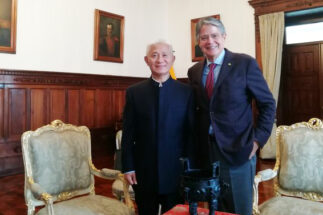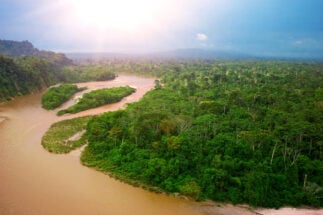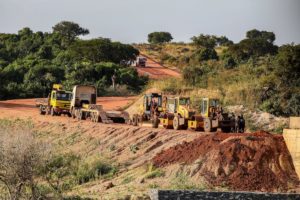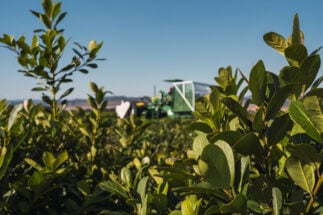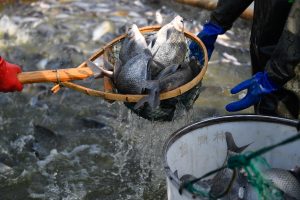Ecuadorian president Guillermo Lasso brought back two pieces of good news from his trip to China this past February. Not only did the Asian country express a favourable position on renegotiating Ecuador’s outstanding bilateral debt, which amounts to US$4.6 billion, but the two countries also kicked off negotiations for a free trade agreement (FTA). Across Latin America, only Peru, Chile and Costa Rica currently have FTAs with China.
“The pandemic has had negative effects on the global economy and Ecuador is no exception,” Lasso said in an official briefing from Quito on 10 February, explaining his administration’s efforts to seek ways to alleviate the country’s difficult economic situation.
One of the specific objectives of the official visit was to try to deactivate an agreement signed during the government of Rafael Correa to repay part of the debt to China with proceeds from oil sales. According to Lasso, these deals included unfavourable conditions for the South American country.
“Approximately two and a bit billion [US] dollars are tied to an oil commercialisation agreement,” the president said in the same televised address from the Carondelet Palace, the seat of the government. He also said that he would seek to extend payment terms and reduce interest rates.

Revised financial cooperation could be mirrored by closer trade cooperation. The memorandum of understanding to begin negotiating a free trade agreement, which was signed in Beijing, could result in a formal pact as early as October, to be signed in the Ecuadorian city of Guayaquil, Lasso said.
The deal could boost Ecuador’s sales of agricultural products to China but also open up competition with vulnerable local manufacturers already reeling from the pandemic. So is the South American country ready for an FTA with China?
Complex negotiations
According to Gustavo Cáceres, president of the Ecuadorian-Chinese Chamber of Commerce (CCECH), the signing of a potential FTA involves hard and complex work, in order to review Ecuador’s “different conditions, problems or opportunities that a trade agreement could have”.
Cáceres told Diálogo Chino that a trade agreement with China is key for agricultural exports to take off. However, he says that such a treaty should be thoroughly analysed and “socialised” – to understand and accept its wider sociocultural consequences – in order to protect other productive sectors that could face tough competition from Chinese counterparts.
“There may be sectors that could have setbacks and we can analyse what measures could be taken to protect or compensate these other sectors over time,” Cáceres said, adding that tax breaks of 10 to 20 years for vulnerable companies could be one solution. He also suggested the possibility of designating some industries as “untouchable”, with protectionist measures to shield them from foreign competition.
Certain industries, such as textiles and footwear, may need extra protection and Lasso assured that, if an FTA is signed, trade liberalisation would be gradual, to give local producers a chance to increase their competitive capability as the market opens up. “We are definitely going to protect [these sectors],” he said.
An ambitious plan
The negotiation of a possible FTA with China also highlights several urgent tasks for the government, according to Felipe Rivadeneira, head of the Ecuadorian Federation of Exporters (Fedexpor). Notably, it must draw up and implement a national export plan, he said.
“Let’s remember that trade agreements not only involve securing a market, but also receiving investment and technology transfer, which is the other interesting part. Logistics have to be improved. And finally, work [must be done] on a competitiveness agenda, that is, to improve productivity,” Rivadeneira said.
Shrimp stands out as a star product in Ecuador’s non-oil export basket, and is perhaps the industry where hopes of boosted sales as a result of the FTA are highest. China remains the main destination, buying 43% of Ecuador’s overseas sales of the crustacean in 2021, a trade worth US$2.3 billion, according to Fedexpor.
US$2 billion
The value of Ecuador's exports of shrimp to China in 2021, according to Fedexpor
“The relationship must become closer to improve the channels of dialogue and technical cooperation to continue the process of market maturation,” José Antonio Camposano, president of the National Chamber of Aquaculture (CNA), told El Universo.
Rivadeneira said: “We have been saying for the last seven years that this market must be secured. To gain better access… with clear rules, without time limits. This helps to increase the flow of investment.”
In 2021, Ecuador exported various products to the Chinese market, with agricultural products and fish accounting for 85% of exports, according to data from Fedexpor and Ecuador’s central bank. Sales of timber and manufactured goods to China were worth US$128 million; balsa wood, used for wind turbine blades, is largely responsible for the figures. Exports of bananas and plantain were worth $104 million, animal feed $68 million and fresh fish (excluding shrimp) $13 million. These figures have made encouraging reading for Ecuadorian entrepreneurs, with hopes that access to the Chinese market may soon open further.
Hopes of an agricultural boom
Producers of pitahaya, a dragon fruit, in particular hope that the volume of shipments to China and other countries will increase. Reinaldo Armijos, manager of the Compañía Anónima Escuela Esinnper, a pitahaya producer and exporter, believes that they could achieve higher numbers if they had more government support in the production phase and in promoting the product abroad.
“Normally, between governments, you can get a list of formal buyers, but [at present] there is no such thing,” Armijos told Diálogo Chino. “As producers we have to go out and look for them. We have gone out to sell to Canada and the United States. We are selling to Spain, but there is no such support.” The company, which has 46 hectares of fruit plantations along the coast, highlands and east of Ecuador, currently ships two to three tonnes of the product abroad each week.
Let’s remember that trade agreements not only involve securing a market, but also receiving investment and technology transfer
Armijos sees the future trade agreement as positive, but also believes that the government should facilitate access to soft loans (loans with interest lower than market rates) from state banks to improve technology, boosting the competitiveness of their fruits and other Ecuadorian products.
Much like for pitahaya, the FTA could offer more opportunities for sales of bananas, says Franklin Torres, president of the National Federation of Banana Growers of Ecuador (FENABE). He believes that the trade agreement would level the playing field between Ecuadorian and Asian exporters.
“This would facilitate both the entry of our products, without the tax currently paid on Ecuadorian bananas, which corresponds to 10% of the sale value, and the export of Chinese products that we need here. For example, it would benefit us with the entry of fertilisers at lower prices than we are receiving now. The same with machinery,” Torres said.
Risks for footwear
Lidia Villavicencio, president of Ecuador’s National Chamber of Footwear (CALTU), told Diálogo Chino that the organisation will closely analyse the sector’s situation and the potential impacts of an FTA with China.
Expectations and concerns in this sector – upon which 118,000 jobs directly depend, according to Villavicencio – centre on fears they will not be able to compete on price with Chinese products, as well as the overall health of the industry following its troubles during the pandemic. For this reason, Villavicencio believes that tariff reductions should be one protective measure.
“We have reduced production and employment generation. Covid-19 was the hardest blow we suffered. Not selling for two years means not producing. Up until 2019, we had 5,400 footwear manufacturers, today we have around 3,600,” Villavicencio laments.
Policies to boost production
While the Ecuadorian government is seeking better conditions for marketing its products overseas, it is also trying to improve production chains in sectors that could take advantage of the greater demand for inputs. Agriculture is one such industry.
Last October, agriculture minister Pedro Álava told an Ecuadorian current affairs programme that the government is seeking to improve farmer practices.
“I am working hard on associated projects. A five-hectare farmer will never be eligible for credit for a tractor, but if I put together 50 farmers with 10 hectares [each], they will be eligible for credit for tractors, equipment, irrigation systems and more,” the minister said.
Diálogo Chino requested an interview with the agriculture ministry to discuss the government’s plans for agriculture, but the ministry did not respond by the time of publication.
The trade agreement with China could also bring in fresh money and investment in telecommunications, automotive assembly lines, and pharmaceuticals. Lasso identified these in his recent economic plan, part of reforms announced in December that seek to reactivate the economy.
Among the measures already being implemented this year is the progressive reduction of 1% on the tax on outflow of foreign currency, from 5% to 4%. He considered the original levy, created during the government of his predecessor Rafael Correa, to be “an entry barrier for investment”.
